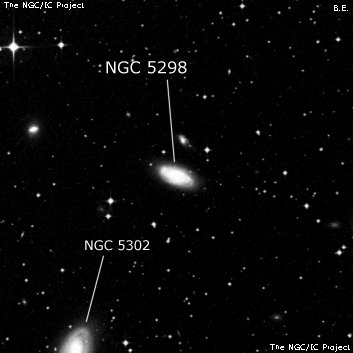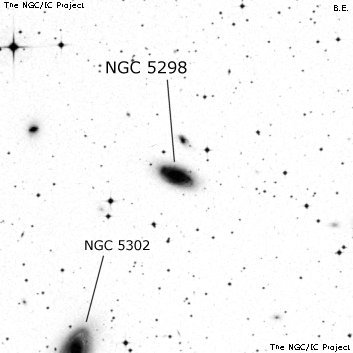NGC/IC Project Restoration Effort
(This is a very very beta version)
NGC5298


Basic Information
Location and Magnitude
Right Ascension: 13:48:36.3
Declination: -30:25:45
Constellation: CEN
Visual Magnitude: 13.1
Historic Information
Discoverer: Herschel J.
Year of discovery: 1835
Discovery aperture: 18.3
Observational
Summary description: F, S, R, gbM
Sub-type: SBb
Corwin's Notes
=====
NGC 5298. Steve Gottlieb has suggested that the traditional identification of
N5298 with ESO 445- G039 may be wrong. Is it possible, he asks, that ESO 445-
G035 is the galaxy that JH saw? His reasoning is that, relative to JH's
observation of N5302, N5298's position is closer to G035 than it is to G039.
This is probably also the source of the RC1, GHD2, and RNGC identifications:
they, too, choose G035.
It looks to me like the most likely explanation is a simple +30 second error
in JH's RA for N5302 due to a mistake in recording the eyepiece wire, and that
his position for N5298 is good. Here are my thoughts.
JH found 34 nebulae during Sweep 564 on 30 March 1835. Comparing his data for
that night with those for the same objects from other nights, he seems to have
had about his usual problem rate (5-10 percent) -- missed nebulae that he
could have picked up, nebulae referred to nearby objects rather than being
measured themselves, etc.
Seven of the objects from sweep 564 are in what became ESO/SRC field 445, so I
looked at the offsets from the modern positions (from ESO-B) in that field. I
found, as Steve did, that NGC 5302 is off the modern position by +31.3 seconds
of time, and that JH's position for N5298 is +26.0 seconds off if he saw G035
rather than G039. Looking at the offsets for the other nearby objects,
though, I don't see any other large offsets:
NGC Delta RA Delta Dec
5264 +0.5s -16"
5292 -0.1s +1'08"
5328 -1.7s +17"
5357 -0.6s +15"
5393 -0.4s +19"
5298 +1.0s -40" if = G039
5298 +26.0s +44" if = G035
5302 +31.3s +1'24"
If we assume that JH saw G035 and made the same 30 second error in the
position of N5298 that he did for N5302, then the offset would be
5298 -5.3s +44"
That much larger negative error suggests to me that the "standard"
identification is more likely to be correct since there are no other large RA
errors in the positions for the five nearby galaxies.
On the other hand, N5298 and N5302 are close enough that JH could have seen
both in the same field, and could have made the same mistake for each.
Steve then says, "I've observed both ESO 445-35 and ESO 445-39 and they appear
similar in the eyepiece with perhaps ESO 445-39 a bit brighter. I don't
understand, though, how he [JH] would picked up one of these galaxies and not
the other."
He clearly had problems in this field. He missed the brightest galaxy here
(IC 4329), and there are several other galaxies in the cluster that he could
have picked up, but didn't. I also did not see anything unusual in his notes
about the field, simply descriptions of the nebulae. In contrast, earlier in
the same night, he made several comments about the NGC 3308/09/11/etc group in
Abell 1060, noting double objects, other objects in the group, and so forth.
For the N5298 area, these comments are missing. I'm guessing here, but
suspect that JH was growing tired, having been at the eyepiece for more than
five hours by the time this group came into view.
I checked the sweep log and found that there were problems with a couple of
objects earlier in the sweep -- JH suspected that the wrong wire was noted.
If so, there could be similar problems with NGC 5298 and NGC 5302. Both were
referred to wire 2 in the log, but if wire 1 was the reference instead, then
each galaxy would have an RA about 36 seconds less than the recorded values.
This would solve the problem for NGC 5302, but would put the nominal position
for NGC 5298 about 10 seconds away from G035. If reduced with respect to wire
2, JH's position is only a second of time away from G039.
Looking at the data, we find that the magnitudes of G035 and G039 are
virtually identical (B = 14.0), and the diameters are not too different,
either. So, the data for the galaxies cannot help us decide which one JH saw.
An additional note: There are several moderately bright stars around G035
that form an eyecatching pattern with the galaxy. I suspect that if JH had
seen this galaxy, he would have commented on the stars as well. This is only
a suspicion, of course, but the configuration is striking on the DSS images.
In the end, I'm going to adopt G039 as NGC 5298, but leave G035 in the table
as a remote possibility.
Steve's Notes
=====
NGC 5298
17.5" (3/12/88): fairly faint, fairly small, oval SW-NE, weak concentration. ESO 445-035 lies 5.7' WSW. Member of the IC 4329 cluster (AGC 3574).



